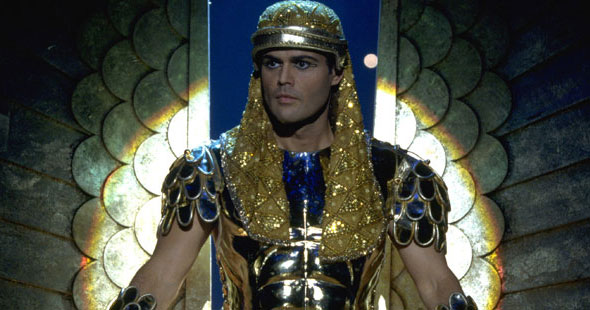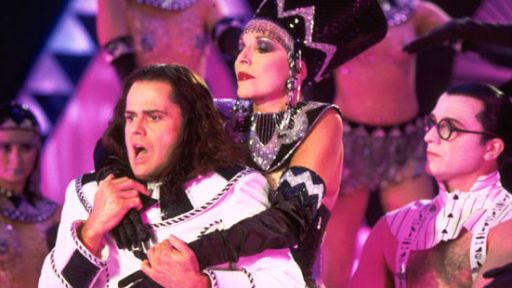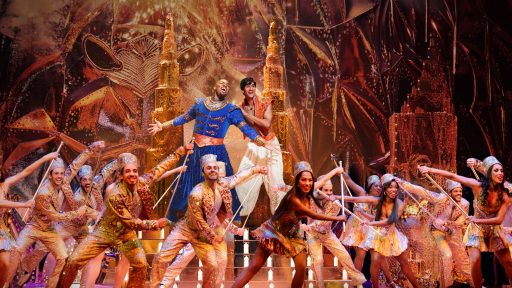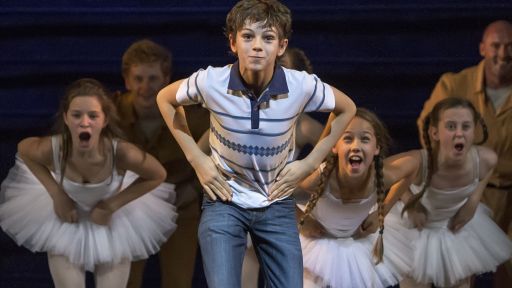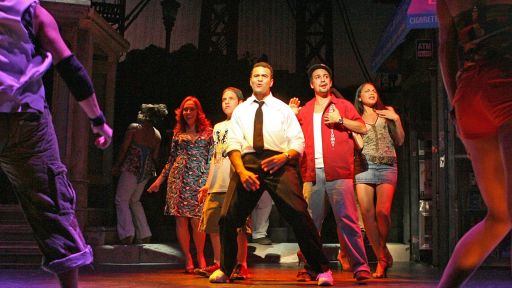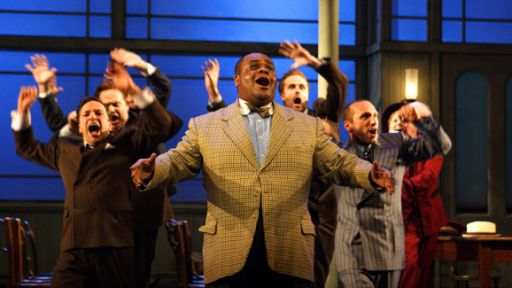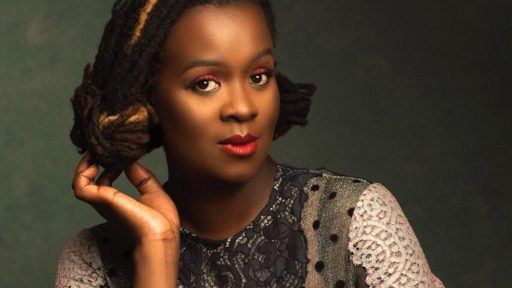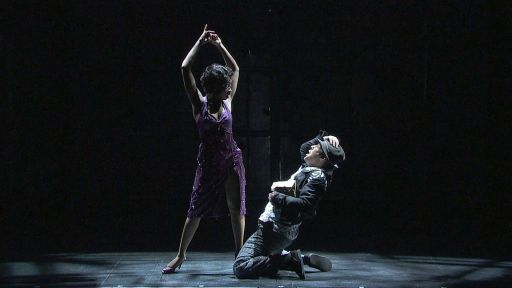England would be unthinkable without her rich tradition of church music. For generations, the soaring sounds of a boys choir have practically defined what it means to be British. But over the past 30 years, the world’s ideas of English music has undergone a startling change. What began as the rock-influenced melodies of a long-haired, upstart composer is today England’s best-known international export.
Good evening. I’m Donny Osmond, and tonight public television is bringing you an evening of music by Andrew Lloyd Webber, the most commercially successful composer of our time. So, why are we in St. Thomas Church in New York City and not a few blocks away on more familiar territority, Broadway? Because Mammon is only part of the story: God has played a starring role as well. For Lord Lloyd-Webber of Sydmonton, the distance from the stage to the sacristy is a lot shorter than you might think.
He’s found inspiration for two of his most famous shows in the Bible, and themes of faith and redemption run throughout his works. Later on this evening, we will return here for Lloyd Webber’s most explicitly liturgical piece: The Requiem Mass he wrote in tribute to his father, also a composer and a renowned London chruch organist. But the Andrew Lloyd Webber the public knows best is [on Broadway], where the composer of “Cats” and “The Phantom of the Opera” continues to dominate the musical. No one’s ever had three shows running simultaneously on Broadway and in London’s West End before, but Andrew’s done it several times. In fact, somewhere in the world, there’s probably a performance of an Andrew Lloyd Webber show going on right now.
The path that took Andrew from the streets of swinging London in the 1960s to his manor house began with a single song. In 1969, Andrew and his lyricist, Tim Rice, burst onto the scene with a hit song that became a best selling album, which became a sensational show that, 30 years later, is returning here to Broadway in a new production opening this month. That song was “Jesus Christ Superstar” — and here, in a nutshell, are the main themes of Webber’s career: religion and the counterculture, the individual against society, sin and redemption — set to some of the most humable tunes ever written.
But even before “Superstar” made Andrew and Tim household words, there was “Joseph.”
For many of us, our school auditorium is where we first saw — and maybe even were in — our first musical. It was in a place much like this that, in 1968, Andrew and Tim launched their career with a short musical for children called “Joseph and the Amazing Technicolor Dreamcoat.” It’s all there in Chapter 39 of Genesis: how Joseph, the favorite of Jacob’s twelve sons, is sold by his brothers into slavery in Egypt and rises to become the Pharaoh’s right-hand man. He saves the empire from a deadly drought and rescues his family as well.
It’s hard to believe now, but back then “Joesph” was only 15 minutes long, performed before an audience of school children and their parents at a London prep school called Colet Court. But the kids loved it, and the critics cheered. Since then, Andrew and Tim have added new characters and songs. “Joesph” has not only become one of their most beloved shows, but also a big part of my life. In fact, it still is. So, get ready for a Bible story you can tap your toes to.
Go, go, go Joseph!
Well, “Joesph” and his brethren have certainly come a long way. And so have the careers of Andrew Lloyd Webber and Tim Rice. But to really understand the show — and the men who wrote it — let’s go back three decades and across the Atlantic. The ’60s were not only a time of radical change in morals, but in fashion and music as well. And the revolution’s epicenter was London.
It was a “youthquake” of political liberation, sexual freedom, and social experimentation. Shorn of Empire, Great Britain became “Little England” — the hippest, most swinging place on earth.
From the boutiques of Carnaby Street to the rock clubs of Liverpool, a new kind of British culture emerged, led by groups like the Beatles. England may have lost her Empire — but she had conquered the world.
But there was a spiritual side to Flower Power, too. Amidst the unabashed hedonism of the age, young people were searching for meaning. Some found it in protest . . . Others sought it in psychedelic drugs . . . Still others found it in God. It might not have been religion as their parents understood it, but it was all part of doing your own thing. And no single work of the 1960s brought youth culture and the New Testament together more controversially than Andrew Lloyd Webber and Tim Rice’s “Jesus Christ Superstar.”
Putting on a Broadway show is a complicated undertaking, requiring the talents of hundreds of people. But the genesis of “Jesus Christ Superstar” was actually very simple. First it was a hit single that swept Europe in 1969. Then it was a best-selling double album, hopping across the Atlantic and topping the charts in America.
Finally, it landed here, on Broadway, where it quickly became one of the most controversial shows in the long history of the Great White Way.
Has there ever been a Broadway show with this kind of cultural impact? “Show Boat” in 1927 and “Oklahoma” in 1943 helped define the modern musical. But the impact of “Jesus Christ Superstar” was felt far beyond 42nd Street. Whether it was hit or miss on stage ultimately didn’t matter, for by 1971 it was already an icon.
Every 20 years or so, it seems that pop culture flings a challenge at American society, forcing us to re-examine our values, our standards — and ourselves.
John Lennon as Jesus? That would have been something. Still, stories about Jesus were in the air. The Greek author Nikos Kazantzakis had published his revisionist novel THE LAST TEMPTATION OF CHRIST just 14 years earlier, and the avant-garde Italian film director Pier Paolo Pasolini had released THE GOSPEL ACCORDING TO ST. MATTHEW five years before. Why not a “rock opera” about the life of Jesus Christ?
Somehow, “Jesus Christ Superstar” not only survived, it flourished:
- in London, where Jim Sharman’s version ran for eight years and broke the record as the longest-running musical in British history.
- in Tokyo, where the acclaimed Shiki production turned Christ’s road to Golgotha into a riveting Kabuki drama.
It even made it to the big screen in 1973, directed by Norman Jewison.
“Superstar” became the foundation of the Lloyd Webber fortune, enabling him to buy his 16th-century manor house, Sydmonton Court, with its sweeping bucolic vistas of the famous Watership Down. There, he turned the estate’s private chapel into a small theater, where all of Lloyd Webber’s musicals are workshopped before heading to his own personal chain of more than 20 London theaters, including the venerable Palace.
Mary Magdalene, trying to figure out whether she loves Jesus as God — or man. Judas played not as a villain, but as a confused and frightened disciple. Sacred or sacrilegious? Even today, the interpretation is in the eye — and the ear — of the beholder.
This concept of creating a hit song or album prior to the show proved to be a formula that suited the team of Rice and Lloyd Webber well.
For their next show, Andrew and Tim chose a subject that, at first glance, doesn’t seem very religious at all: the life of Eva Peron, wife of the Argentine dictator. But look more closely: worshipped by millions, the latter-day “Santa Evita” turned out to be a fickle, false goddess. But oh what a circus! What a show!How did Andrew come by his choice of profession? And where does he get his inspiration? For the answers, we have to go back to his boyhood in London’s South Kensington. Andrew’s father, William Lloyd Webber, was a well-known figure on the British music scene. During his varied career, he was the organist at two important London churches — All Saints, Margaret Street, and Central Hall, Westminster — a professor of composition and harmony at the Royal College of Music, and the director of the London College of Music. He was also a classical composer, and it was a source of lifelong frustration for him that his music was not more widely performed.
Andrew was born in 1947, the elder of the two sons of Bill and Jean Lloyd Webber. It was a happily, noisily musical household. While Andrew was staging imaginary musicals in a toy theater, his brother Julian would be sawing away on the cello. Another member of the Lloyd Webber managerie was John Lill, who was practically adopted by Andrew’s parents, and who grew up to be one of the finest British pianists of his generation.
Andrew Lloyd Webber continues to explore religious and liturgical themes — sometimes in surprising ways.
In “Cats,” the tattered prostitute Grizabella — the feline Mary Magdalene — is chosen by Old Deuteronomy to ascend to heaven — the “Heaviside Layer.” A levitating car tire — now that’s getting into Heaven the hard way! After nearly 20 years, “Cats” is finally heading towards the end of its Broadway run after shattering every box office record. But its “Memory” lingers on.
Even the “Phantom of the Opera” gets into the act, composing his operatic masterpiece at a mighty organ and hoping the beautiful Christine Dae will save him from his subterranean misery — both as a musician and as a man.
Even today in his later works, the theme of faith — or lack of it — is never very far beneath the surface.
“Whistle Down the Wind” is the story of a mysterious stranger — an escaped convict — who is mistaken for none other than Jesus Christ by a group of innocent school children. Lloyd Webber and his librettists transposed the action of the 1961 film starring Hayley Mills and Oliver Reed from rural England to Bible-belt Louisiana. For a secular work, the song titles themselves tell the real story: “The Vaults of Heaven,” “I Never Get What I Pray For,” “The Vow,” “Long Overdue for a Miracle,” “Wrestle with the Devil.” Sin, death, and redemption loom large in the show, both as text and subtext.
What is it about this subject that resonates with Lloyd Webber? Why, in show after show, has he chosen material that deals, in one way or another, with religion? In his new work, he is adapting the novel BEAUTIFUL GAME, which deals with the Troubles between Catholics and Protestants in Northern Ireland.
In 1985 — right here in St. Thomas Episcopal Church — Andrew Lloyd Webber finally gave full voice to his lifelong interest in religious themes. The work was the “Requiem,” a complete setting for soloists, chorus, and orchestra of the ancient liturgy that has long fascinated opera composers. Mozart wrote a Requiem Mass, so did Giuseppe Verdi. From the thundering “Dies Irae” — the Day of Wrath — to the joyful “Hosannah,” the “Requiem” affords composers a chance to shine.
Andrew made the most of the “Requiem” — right down to composing a hit tune, “Pie Jesu.” The score won the Grammy Award for the best classical album that year, and director Stephen Frears filmed “Pie Jesu” as a tribute to the young victims of war everywhere.
I’m in St. Thomas Episcopal Church in New York City. It was here, in 1985, that Andrew Lloyd Webber premiered his only major departure from the Broadway stage, the “Requiem.” Inspired both by the ongoing strife in Northern Ireland and by the atrocities of the Khmer Rouge in Cambodia, the “Requiem” was also a tribute to Andrew’s father. That first performance was conducted by Lorin Maazel and starred tenor Plácido Domingo, a boy soprano named Paul Miles-Kingston, and a young coloratura called Sarah Brightman — at the time, the new Mrs. Andrew Lloyd Webber. Andrew would go on to write another important piece for her, “The Phantom of the Opera,” before their divorce in 1990.
All the sounds Andrew heard as a child resonate throughout the “Requiem”: his father’s church music, as well as the sacred choral works of Handel, Holst, Elgar, and Benjamin Britten. Following the example of Brahms and Fauré, Lloyd Webber omits violins from the orchestration, creating a striking contrast between the darkness of the orchestra and the bright, light voices of the tenor and the two sopranos. It is at once Lloyd Webber’s most personal work — and his most English.
We can still hear the echoes of the “Requiem” today. Its most famous number, the haunting “Pie Jesu,” was recently recorded by Charlotte Church. Once again, Andrew Lloyd Webber has a hit.
Based on the Roman Catholic Mass for the dead, a requiem is constructed in clearly defined, self-contained sections. Each movement is named after a liturgical prayer, and is sung mostly in Latin. Charting mankind’s journey from the death of the body to the eternal life of the soul, a requiem emotionally invokes the terror of the Last Judgment, the sorrow of our separation from God through sin, and, finally, the bliss of eternal peace. It’s easy to see why so many composers, whether personally religious or not, have been attracted to the form: in its stirring dramatic progression, a requiem is really an unstaged opera, in which the central character is all of us.
Andrew Lloyd Webber’s “Requiem” follows the classical model of Mozart and Verdi. Massed choruses are complemented by moments of exquisite tenderness for the soloists. Its movements include a frightening “Dies Irae,” a spirited “Hostias,” a jubilant “Hosannah” — which brings a little bit of Broadway to the altar — and a gorgeous “Lux Aeterna” as the soul is bathed in God’s eternal, perpetual light. The “Requiem” is Lloyd Webber’s most ambitious work, and his most heartfelt.

